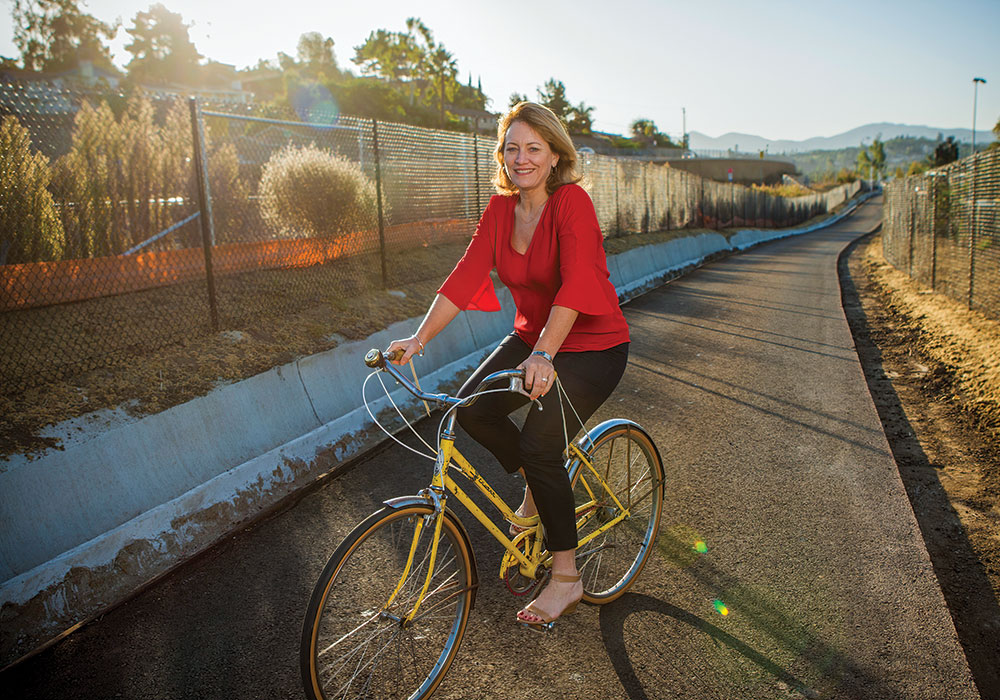Planning January 2020
Equity
Finding the Path from Equal Treatment to Equal Outcomes
Sherry Ryan wants to change the way we think about gender in planning practice — and get more women on bikes.
By Lindsay Nieman
Mounting evidence reveals that different genders have different demands on the built environment, public services, and amenities — but planning interventions have largely only accounted for the needs of cisgender men. Sherry Ryan, PhD, is looking to change that.
"When women are not well supported, communities are not well supported," says the professor of city planning in the School of Public Affairs at San Diego State University.

Sherry Ryan is an active transportation planner in San Diego, California. Photo by J. Kat Photo, Inc.
Planning spoke with Ryan about gender mainstreaming, the subject of her new PAS Memo, and the need for a more inclusive approach to bike planning.
What does gender mainstreaming mean?
The most frequently cited definition is from a 1997 United Nations' report from the Economic and Social Council:
"Mainstreaming a gender perspective is the process of assessing the implications for women and men of any planned actions, including legislation, policies, or programmes, in all areas and at all levels. It is a strategy for making women's as well as men's concerns and experiences an integral dimension of the design, implementation, monitoring, and evaluation of policies and programmes in all political, economic, and societal spheres, so that women and men benefit equally and inequality is not perpetuated."
The power and appeal of gender mainstreaming is that it goes beyond gender-targeted policies and supports assessing all policies for their impacts on different genders, with the explicit goal of addressing potential inequality of outcomes. The approach is preemptive rather than reactionary. Its focus is on avoiding unequal outcomes, not ensuring equal treatment, based upon the idea that treating groups equally does not always result in equal benefits.
As a policy development process, it is ripe for application to local long-range planning, especially in the U.S.
How does a lack of gender mainstreaming impact communities?
Gender inequity is being perpetuated in various aspects of the built environment, mainly land-use patterns, streetscape design, and mobility infrastructure — in other words, the basic components of our urban fabrics — because of a lack of gender mainstreaming in our work.
We need to parse out women's experiences and make sure we're accounting for the group's reality. We are doing most of the household and childcare maintenance activities, which becomes burdensome in separated land uses; and we are more transit dependent than men, which also becomes burdensome in auto-dominated urban fabrics.
What's most important for planners to know?
Planners need to advocate for all planning data to be assessed in a manner that is disaggregated by gender. We need to compile and present not only objective data by gender, but also qualitative data, or data from community outreach. If women's voices aren't being identified and accounted for, then half the population isn't being heard, and planning outcomes won't be successful.
How did you get interested in this topic?
It was out of frustration with the fact that women aren't riding bikes. I've been doing long-range bicycle planning for a while, and women don't lead these projects and they don't use the facilities. Early on, I experienced an incredibly destructive attitude in the bicycle planning field where if you didn't show up as an experienced cyclist, you couldn't be taken seriously as a planner doing this work. It was very male dominated, and consultants were using this tactic that if you couldn't show you rode a bike, then you couldn't do the work. Of course, this attitude is highly exclusionary and ridiculous. We don't check that you can drive a car before you design vehicular infrastructure; we don't check that you use transit before you can plan for it. My attitude is that the average traffic engineer should be an expert bike facility designer.
How do you approach gender mainstreaming in your work?
I have understood the lack of female cyclists for a while, and have been advocating for protected bike infrastructure. It's a known rule of thumb in bicycle planning that roughly 60 percent of people have cautious attitudes toward cycling, and wouldn't use this mode unless there are protected facilities. Fewer planners and academics have made the connection that the "60 percent" likely correlates to the 50 percent total female population. It underscores the fact that if women don't have access, then communities don't have access — and this describes the world of bicycle planning and infrastructure.
How can other planners make sure their work supports all genders?
Start by writing scopes of work for all plans and projects — large and small — that call for collecting and analyzing all planning data by gender.
Lindsay Nieman is an associate editor of Planning magazine.


